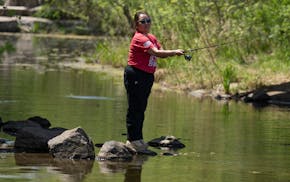If you've been bothered by an unrelenting buzz of mosquitoes lately, welcome the season's emergence of dragonflies — they'll help save you from the torment.
These sometimes jewel-colored marvels, with gleaming or spotted wings, can eat up to 100 mosquitoes a day. They take out pesky gnats and midges, as well.
Species with names such as chalk-fronted corporals, twelve-spotted skimmers, and pondhawks are now coming out of rivers, ponds and lakes after living as aquatic nymphs, where they also helped control mosquitoes by eating the larvae.
Early risers might be able to see a dragonfly emerge from its larval stage at dawn, clinging to vegetation, a rock or a dock as its exoskeleton cracks open. The head, compressed wings, legs and abdomen emerge during this metamorphosis, new body parts harden, and blood flows to the wings, allowing the dragonfly to take off for a new life on land.
Dragonflies rank among Earth's earliest winged insects. Fossils of supersized ancestors show they existed more than 300 million years ago, long before dinosaurs. They're known for compound eyes, with more than 30,000 simple eyes that given them 360-degree vision. They also have four independent wings that let them fly up, down and side to side, inspiring the design of helicopters.
As summer progresses, you might spot male and female dragonflies mating, creating a circle or heart shape while connected. Fertilized eggs hatch into nymphs, which can live under water for one to three years. They get big enough to eat tadpoles and minnows. Nymphs, in turn, can be popular food for fish. Dragonflies zooming through the air can nourish birds in need of protein.
You can learn more about Minnesota's many species through Kurt Mead's "Dragonflies of the North Woods" field guide and the Minnesota Dragonfly Society. Look for sightings on the society's Facebook page.
Lisa Meyers McClintick has freelanced for the Minnesota Star Tribune since 2001 and volunteers as a Minnesota Master Naturalist.

Dragonflies are swooping in to help with mosquito control

Author Kao Kalia Yang once fished to help feed her family. Now she shares the pastime with her children.
Anderson: He paddled solo into the BWCAW and didn't come back

Accomplished climber, photographer who recently moved from St. Paul missing on mountain
dj](https://arc.stimg.co/startribunemedia/34QSKO44B2XKVNUZCO5SLJQSLY.jpg?h=91&w=145&fit=crop&bg=999&crop=faces)
